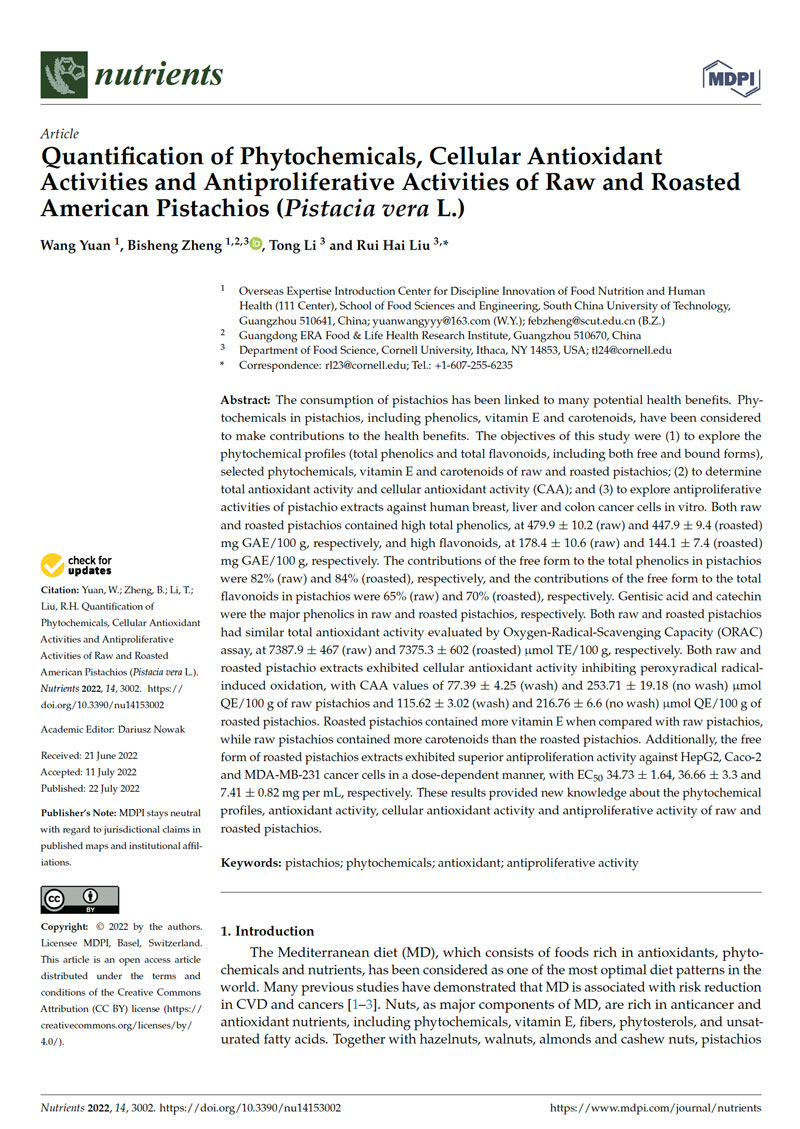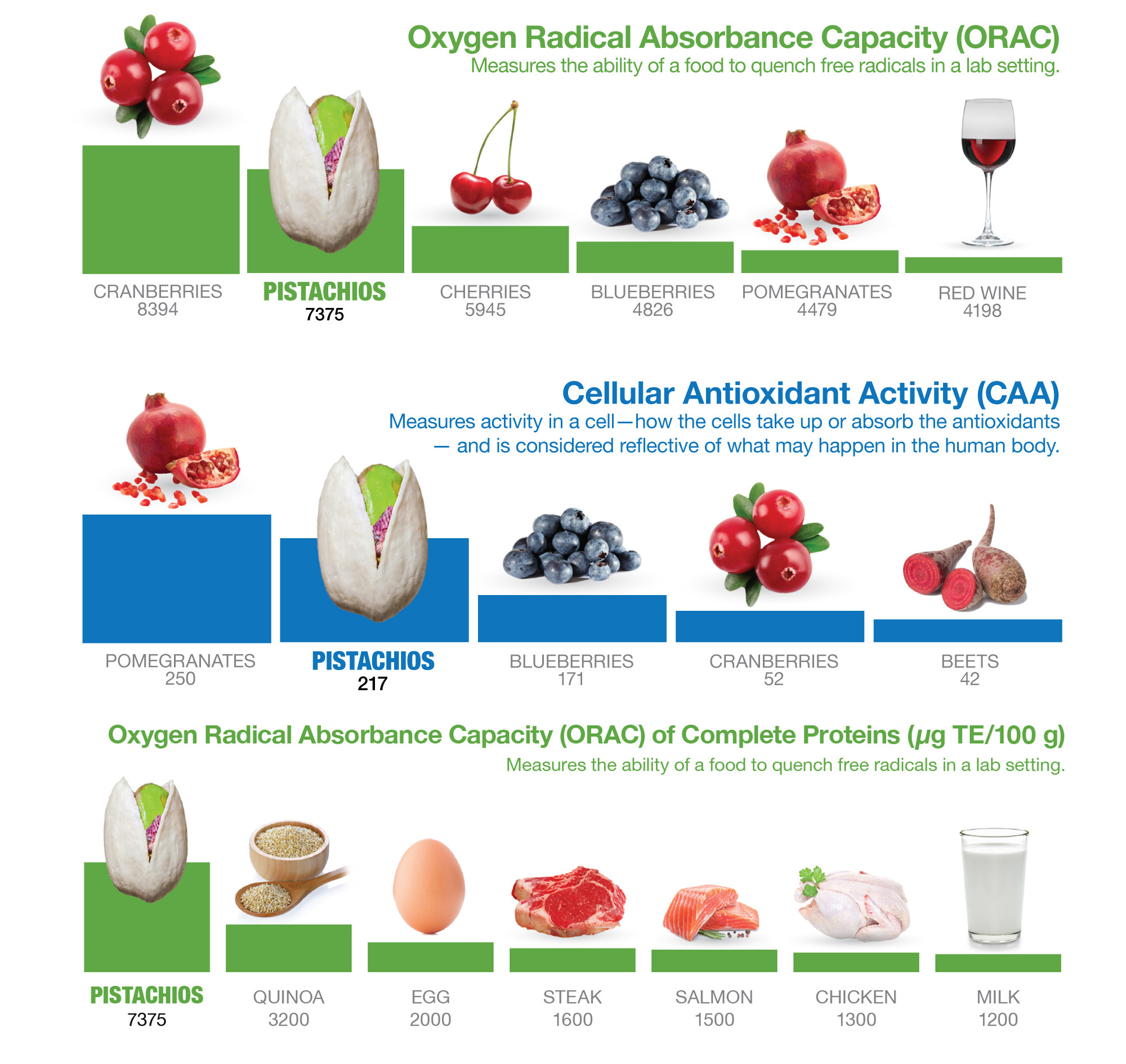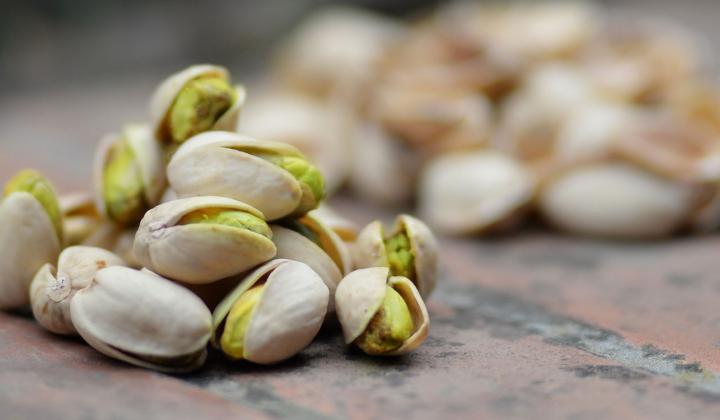NEW STUDY REVEALS PISTACHIOS ARE AN ANTIOXIDANT POWERHOUSE
Pistachios have a high antioxidant capacity that rivals that of popular antioxidant-containing foods.
FRESNO, Calif., Oct. 17, 2022 – Antioxidant-rich foods are regularly encouraged as part of a healthy lifestyle, and research suggests that a diet high in antioxidants may even help to reduce the risk of death.[1] While certain fruits and vegetables are often thought of as high-antioxidant foods, a new study conducted by Cornell University and published in the journal, Nutrients, produced surprising results[2]. Pistachios have a very high antioxidant capacity, among the highest when compared to values reported in research of many foods commonly known for their antioxidant capacity, such as blueberries, pomegranates, cherries, and beets.[3],[4],[5]
Researchers from Cornell University wanted to better understand the potential mechanism behind the health benefits that have been linked to pistachios in recent studies. They analyzed pistachios to determine:
- The makeup of pistachio phytochemicals – compounds within plants that may help to lower the risk of chronic diseases and keep the body working properly.
- The antioxidant power of pistachios.
- Whether pistachio extracts can help to inhibit the growth of tumor cells (breast, liver and colon cancer cells) in a laboratory setting.
The researchers used the two different methods to measure the antioxidant potential of pistachios – Oxygen Radical Absorbance Capacity (ORAC) and Cellular Antioxidant Activity (CAA) – and found that pistachios have very high level of antioxidant activities.
“We were excited to see that the antioxidant capacity of pistachios measured so high in our study,” said Dr. Rui Hai Liu, Professor of Food Science at Cornell University. “When compared to values reported in research for other common, high-antioxidant foods using the same methods, we see the antioxidant activity of pistachios is higher than that of foods often thought of as antioxidant powerhouses including blueberries, cherries, and beets.2,3,4,5 We believe the high antioxidant activity of pistachios may to be due to the unique compounds in pistachios including vitamin E, carotenoids, phenolics and flavonoids. The combination or interaction of these beneficial antioxidants, bioactive compounds, along with other nutrients in pistachios, is likely what contributes to the many health benefits we have seen in pistachio studies from recent years.”
Normal metabolisms of daily life – everything from eating, breathing, and exercising to the toxins we encounter in the environment – can generate free radicals in the body. Free radicals attack healthy body cells and this damage is thought to contribute to inflammation and aging in addition to chronic health conditions, including heart disease and cancer. Health professionals recommend antioxidants from food sources to help protect healthy cells from free radical damage in the body.[6],[7]
Most people know that antioxidants are beneficial to health, but many don’t know exactly how antioxidants work within the body. To see an informational video on antioxidants, go to https://AmericanPistachios.org/.
Pistachios are High in Antioxidants
A new study conducted by Cornell University and published in the journal, Nutrients, determined that pistachios have a very high antioxidant capacity, among the highest when compared to values reported in research of many foods commonly known for their antioxidant capacity, such as blueberries, pomegranates, cherries, beets, and red wine.1,2,3,4 The purpose of the research was to measure the level of antioxidant “capacity” of pistachios.

A summary of additional findings from the study include:
- Pistachios have a wide variety of important phytochemicals including different members of the vitamin E family (β-tocopherol and γ-tocopherol), carotenoids (lutein, zeaxanthin and beta-carotene), phenolics and flavonoids.
- Pistachios have high antioxidant activities as measured by both ORAC and CAA.[2] CAA measures antioxidant activity in a cell—how the cells take up or absorb the antioxidants—and is a more physiologically relevant assay and considered reflective of what may happen in the human body when compared to the chemical antioxidant assays3.
- Pistachio phytochemical extracts showed potent antiproliferative activities against human breast, liver and colon cancer cells in vitro with exceptionally high activity seen against the human breast cancer cells. Pistachio phytochemical extracts were shown to inhibit cancer growth in all three cancer cells (breast, liver and colon) without causing cytotoxicity to the cells. The researchers report that this area of study is worthy of future research to determine how pistachio extracts are blocking the growth of cancer cells as seen in this new study. Interestingly, population studies show an association with high frequency of nut consumption and reduced risk of certain cancers.[8], [9]
“The health benefits of pistachios have been studied over the past 20 years and we are excited to dig further into the specific makeup of pistachios that maybe contributing to overall health,” notes Amber Wilson, MS, RD, Director of Nutrition Research and Communication for American Pistachio Growers. “The results of this study confirm the high antioxidant potential of pistachios, which is great news for those looking to add more antioxidant whole foods to their diet.”
Pistachios used in the Cornell study were grown in California and have a different nutritional profile than those grown in other countries.
Pistachios grown in the U.S. are also a plant-based source of complete protein. One serving of pistachios (1 oz or 49 kernels) is an excellent source of copper and a good source of protein, fiber, vitamin B6, phosphorus and thiamin.
For more information about research on the health benefits of pistachios, visit https://americanpistachios.org/nutrition-and-health.
Notes to Editor:
Why is there such global interest in American-grown pistachios in recent years? Baby Boomers recall the bubble-gum machines that dispensed red-dyed pistachios imported from Iran when they were youngsters. At the time, no pistachios were produced domestically.
Pistachios are one of the newest commercial crops in the United States, first established in California in the 1970s from the seed of Iranian pistachios, which grew in a bush form. Through crop improvement, research conducted by USDA and California universities, a robust pistachio tree was developed, and it thrived in the arid climates in California, Arizona, and New Mexico. The American pistachio is therefore physiologically different, producing a nutmeat with a nutrient profile that differs from the original nuts from Iran and other origins, such as the Bronte region of Italy.
Soon, interest piqued in nutrition research of the improved pistachio. Over the subsequent years, research has been conducted by respected universities and institutions in Europe, China, Canada, and the United States, resulting in published studies that revealed many health benefits that make American-grown pistachios unique among other foods. Notably, in March 2020, it was announced that American-grown pistachios are among the few plant-based proteins that are also a complete protein—meaning they contain the nine essential amino acids that are necessary for human growth that is mostly found in animal proteins.
Click on charts below for download.
A compendium of the global research can be found at AmericanPistachios.org.
Contact:
Amber Wilson
Director, Nutrition Research and Communication
awilson@americanpistachios.org
Ph. (310) 384-4251
[1] Jayedi A, Rashidy-Pour A, Parohan M, Zargar MS, Shab-Bidar S. Dietary Antioxidants, Circulating Antioxidant Concentrations, Total Antioxidant Capacity, and Risk of All-Cause Mortality: A Systematic Review and Dose-Response Meta-Analysis of Prospective Observational Studies. Adv Nutr. 2018 Nov 1;9(6):701-716. doi: 10.1093/advances/nmy040. PMID: 30239557; PMCID: PMC6247336.
[2] Yuan W, Zheng B, Li T, Liu RH. Quantification of Phytochemicals, Cellular Antioxidant Activities and Antiproliferative Activities of Raw and Roasted American Pistachios (Pistacia vera L.). Nutrients. 2022; 14(15):3002. https://doi.org/10.3390/nu14153002
[3] Wolfe KL, et al. Cellular Antioxidant Activity (CAA) Assay for Assessing Antioxidants, Foods, and Dietary Supplements. J Agric. Food Chem. 2007, 55, 8896–8907.
[4] Song W, et al. Cellular Antioxidant Activity of Common Vegetables. J. Agric. Food Chem. 2010, 58, 6621–6629. DOI:10.1021/jf9035832
[5] Wolfe, K., Kang, X., He, X., Dong, M., Zhang, Q., and Liu, R.H. Cellular antioxidant activity of common fruits. J. Agric. Food Chem. 56 (18): 8418-8426, 2008.
[6] Ellis, E. “Antioxidants – Protecting Healthy Cells” Academy of Nutrition and Dietetics. Published March 25, 2021. Accessed September 19, 2023. https://www.eatright.org/food/vitamins-and-supplements/types-of-vitamins-and-nutrients/antioxidants-protecting-healthy-cells
[7] “Understanding Antioxidants” Harvard School of Public Health. Published January 21, 2019. Accessed September 16, 2022. https://www.health.harvard.edu/staying-healthy/understanding-antioxidants
[8] Bao Y, et al. Association of Nut Consumption with Total and Cause-Specific Mortality
N Engl J Med 2013; 369:2001-2011. DOI: 10.1056/NEJMoa1307352
[9] Aune D, Keum N, Giovannucci E, Fadnes LT, Boffetta P, Greenwood DC, Tonstad S, Vatten LJ, Riboli E, Norat T. Nut consumption and risk of cardiovascular disease, total cancer, all-cause and cause-specific mortality: a systematic review and dose-response meta-analysis of prospective studies. BMC Med. 2016 Dec 5;14(1):207. doi: 10.1186/s12916-016-0730-3. PMID: 27916000; PMCID: PMC5137221.

American Pistachio Growers













